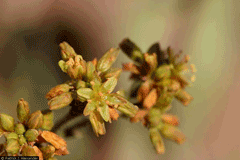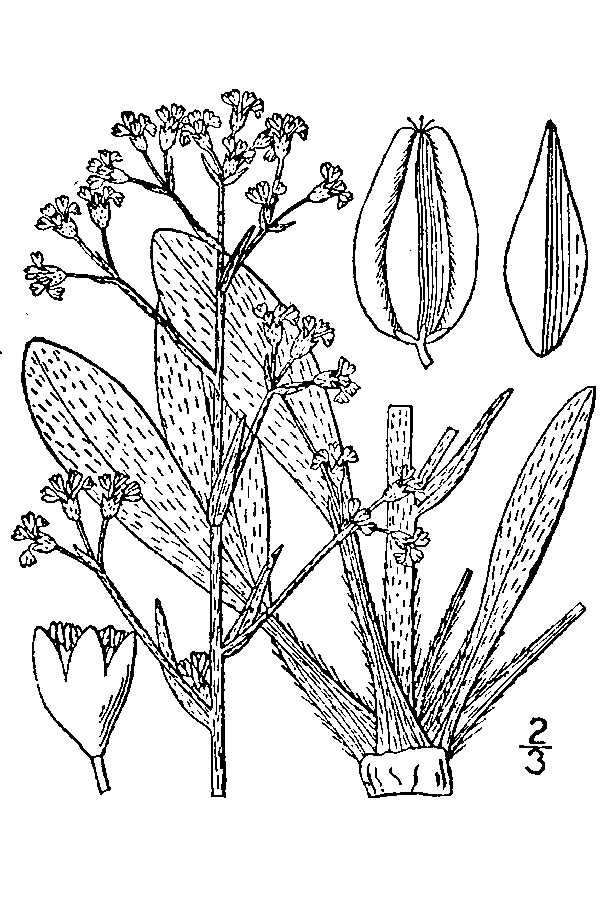 |
|
Patrick J. Alexander @ USDA-NRCS PLANTS Database |
 |
| USDA-NRCS PLANTS Database / Britton, N.L., and A. Brown. 1913. An illustrated flora of the northern United States, Canada and the British Possessions. Vol. 1: 648. |
Translate this page:
Summary
Physical Characteristics

 Eriogonum alatum is a PERENNIAL growing to 0.8 m (2ft 7in). It is in flower from July to October. The species is hermaphrodite (has both male and female organs).
Eriogonum alatum is a PERENNIAL growing to 0.8 m (2ft 7in). It is in flower from July to October. The species is hermaphrodite (has both male and female organs).
Suitable for: light (sandy) and medium (loamy) soils, prefers well-drained soil and can grow in nutritionally poor soil. Suitable pH: mildly acid, neutral and basic (mildly alkaline) soils. It cannot grow in the shade. It prefers dry or moist soil. The plant can tolerates strong winds but not maritime exposure.
UK Hardiness Map
US Hardiness Map
Synonyms
Plant Habitats
Cultivated Beds;
Edible Uses
Edible Parts: Root Seed
Edible Uses:
Root - raw or dried for later use[155, 177, 257]. Seed - ground into a powder and made into a mush[257].
References More on Edible Uses
Medicinal Uses
Plants For A Future can not take any responsibility for any adverse effects from the use of plants. Always seek advice from a professional before using a plant medicinally.
Anodyne Salve
The plant has been used in the treatment of pain and also to make a lotion to treat rashes[155, 257]. A cold infusion of the root has been used to treat diarrhoea and bad coughs[257]. It has also been used as a mouthwash for sore gums[257]. The powdered root has been mixed with oil and used as a dressing on a baby's sore navel[257]. The Navajo (Diné) people consider the species to be a 'life medicine', using a mixture of shredded roots and water primarily to treat internal ailments[270]. The species is used as a ceremonial medicine[270]. The Zuni use it as an emetic for stomachaches[270].
References More on Medicinal Uses
The Bookshop: Edible Plant Books
Our Latest books on Perennial Plants For Food Forests and Permaculture Gardens in paperback or digital formats.

Edible Tropical Plants
Food Forest Plants for Hotter Conditions: 250+ Plants For Tropical Food Forests & Permaculture Gardens.
More

Edible Temperate Plants
Plants for Your Food Forest: 500 Plants for Temperate Food Forests & Permaculture Gardens.
More

More Books
PFAF have eight books available in paperback and digital formats. Browse the shop for more information.
Shop Now
Other Uses
References More on Other Uses
Cultivation details
We have very little information on this species and do not know if it will be hardy in Britain. There are two main forms of the plant, the type variety (Eriogonum alatum var. alatum) is rarely cultivated since an individual plant may go up to seven (or more) years before flowering, after which it dies[270]. It is unclear whether the variety glabriusculum also does this[K]. The notes below are based on the needs of other members of this genus. Requires a loose lean gritty well-drained soil in a very sunny position[200]. Succeeds in dry soils. Tolerates exposed positions[200]. Requires some protection from winter wet[1]. Established plants resent root disturbance[200].
References Carbon Farming Information and Carbon Sequestration Information
Temperature Converter
Type a value in the Celsius field to convert the value to Fahrenheit:
Fahrenheit:
The PFAF Bookshop
Plants For A Future have a number of books available in paperback and digital form. Book titles include Edible Plants, Edible Perennials, Edible Trees,Edible Shrubs, Woodland Gardening, and Temperate Food Forest Plants. Our new book is Food Forest Plants For Hotter Conditions (Tropical and Sub-Tropical).
Shop Now
Plant Propagation
Seed - best sown as soon as it is ripe in the autumn in a sandy compost in a greenhouse. Sow stored seed in early spring in a warm greenhouse[1]. As soon as they are large enough to handle, prick the seedlings out into individual pots and grow them on in the greenhouse for at least their first winter. Plant out in late spring or early summer, after the last expected frosts. Division in early spring[1]. This has to be done with care because the plant resents root disturbance[200]. Try to obtain divisions from around the edges of the plants without digging up the whole clump. Tease the divisions out with as much root on them as possible and pot them up. Grow them on in light shade in the greenhouse until they are rooting well and plant them out in the summer. Cuttings of greenwood with a heel in the summer[200].
Other Names
If available other names are mentioned here
Native Range
NORTHERN AMERICA: United States (Kansas (west), Nebraska (southwest), Oklahoma (west), Colorado, Wyoming (southeast), New Mexico, Texas (n. & w.), Arizona, Utah (east)), Mexico (Chihuahua)
Weed Potential
Right plant wrong place. We are currently updating this section.
Please note that a plant may be invasive in one area but may not in your area so it's worth checking.
Conservation Status
IUCN Red List of Threatened Plants Status :

Growth: S = slow M = medium F = fast. Soil: L = light (sandy) M = medium H = heavy (clay). pH: A = acid N = neutral B = basic (alkaline). Shade: F = full shade S = semi-shade N = no shade. Moisture: D = dry M = Moist We = wet Wa = water.
Now available:
Food Forest Plants for Mediterranean Conditions
350+ Perennial Plants For Mediterranean and Drier Food Forests and Permaculture Gardens.
[Paperback and eBook]
This is the third in Plants For A Future's series of plant guides for food forests tailored to
specific climate zones. Following volumes on temperate and tropical ecosystems, this book focuses
on species suited to Mediterranean conditions—regions with hot, dry summers and cool, wet winters,
often facing the added challenge of climate change.
Read More
Expert comment
Author
Torr.
Botanical References
235270
Links / References
For a list of references used on this page please go here
Readers comment
© 2010, Plants For A Future. Plants For A Future is a charitable company limited by guarantee, registered in England and Wales. Charity No. 1057719, Company No. 3204567.